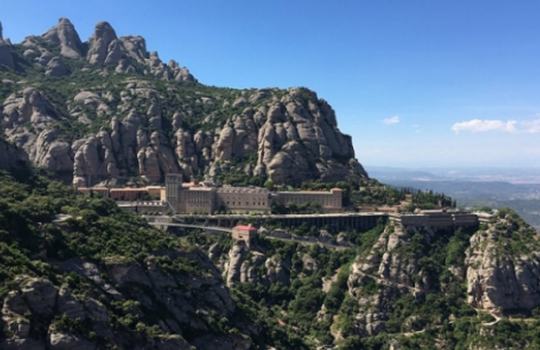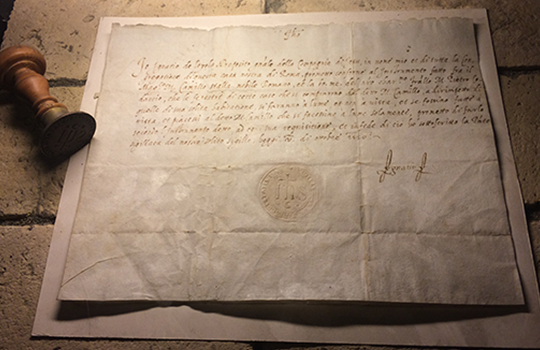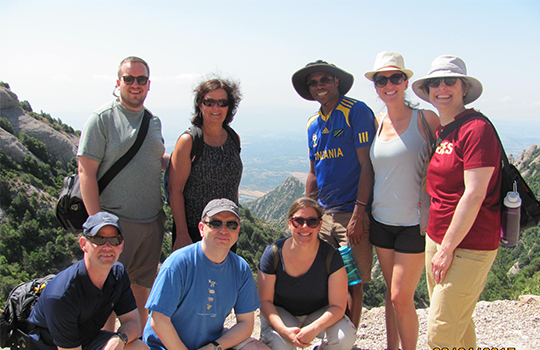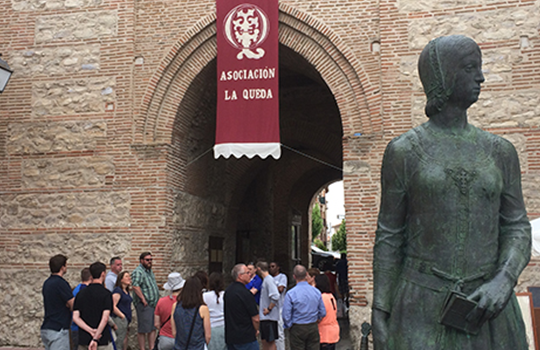Immersion Itinerary
The annotated itinerary below explains the sites visited each day as well as the day’s unique theme for the Certificate’s Immersion course. Daily readings, group presentations, and writing assignments foster thoughtful and informed reflections on each theme’s historical and spiritual importance.
The immersion course begins with preliminary online readings and discussions. Participants then meet in Madrid and are provided with informed, scholarly direction to unique opportunities through Spain and Italy.
The immersion course exposes participants to unique opportunities, thematic readings, daily liturgy, and group discussions so that they might critically examine the foundations of the Society of Jesus. The short-term goal of the travels is for the participants to deepen their understanding of the spirituality, history, and leadership methods associated with the Society of Jesus. More long term, it is the hope that their time together will ultimately assist the participants' personal and professional vocations, paying dividends long after they have traveled in the footsteps of leaders.
Through the annotated itinerary, please explore the sites and themes for each day. Daily reflections by previous travels are also available.
“ It was hard work, but it was well worth it. The experience was a unique and thrilling one, with travel to and investigation of historical Jesuit sites in Spain and Italy.... A cohort of Jesuit educators and administrators, with some not directly connected to Jesuit institutions, contributed to vibrant and immersive discussion of issues past and present. ”
Typical Itinerary for Immersion
Day 2: Madrid, Arévalo, Burgos, and Loyola
Day 4: Loyola, Aranzazu, Pamplona, Javier, and Sos del Rey Católico
Day 5: Sos del Rey Católico, Zaragoza, Verdú, and Montserrat
Day 6: Montserrat and Barcelona
Day 1: Orientation in Madrid
Participants meet in the capital of Spain for an orientation session with the course instructors. Everyone will have already engaged with one another through online discussions and reading each other’s pre-travel reflection papers. Those assignments provide the basis the day’s discussion, in which the instructors will also explain the nature and expectations of the upcoming travels. The group dines together for dinner and spends the night in Madrid.
Day 2: Madrid, Arévalo, Burgos, and Loyola
With the travels and reading assignments for our second day in Spain, we examine the Iberian roots of some of the early Jesuits. The sites and texts prompt us to consider how both the region’s chivalric culture and those Catholics with Jewish ancestry (or conversos) influenced the foundation and early work of the Society of Jesus. We awake early in Madrid and head northwest to Arévalo where Ignatius of Loyola, beginning at the age of 15, served as a page for a major official to King Ferdinand. Our travels continue northeast to Burgos, the hometown of the most important converso in the Society of Jesus, Juan Alfonso de Polanco, who served as the order’s secretary and Ignatius’s collaborator in composing the Constitutions. In Burgos, we visit the Church of San Nicolás and view its ornate high altar that contains the tombs of Polanco’s parents and grandparents. Everyone is free to enjoy lunch in this charming medieval city. We arrive in Azpeitia (Loyola) in the late afternoon, with enough time to briefly explore the town before we dine as a group at the Arrupe Hotel, where we will spend the night.
Day 3: Loyola and Azpeitia
The theme for the day is Young Ignatius, and we venture into the town Azpeitia. We visit the church in which Ignatius was baptized as well as the church outside of which he preached and the hospital in which he lived and worked upon his return after his studies in Paris. We have lunch as a group in the hotel, afterwards we have a guided tour of Ignatius’s childhood home. The tour culminates with a private visit to the room where Ignatius experienced his spiritual conversion. Our readings include some of the very texts that Ignatius read leading up to his conversion as well as accounts of how Ignatius later assisted others through spiritual conversation. We also visit the basilica adjacent to the castle—together forming much of the Sanctuary of Loyola—as well as the Loyola family archives. People are free to explore the city in the afternoon. We will have a seminar discussion in the evening and dine together before we spend a second night in Loyola.
Day 4: Loyola, Aranzazu, Pamplona, Javier, and Sos del Rey Católico
Conversion is the theme of our third day in Spain. We depart Azpeitia as Ignatius did in 1522, by stopping at the Hermitage of Olatz. Our second stop marks where Ignatius stopped on his pilgrimage, Our Lady of Aranzazu, a sanctuary resting along a mountain range. We arrive next in Pamplona, visiting the site where Ignatius was wounded defending the city against the French in 1521. Everyone is free to have lunch. Our next stop is in Javier (Navarre) where we tour the castle in which Francis Xavier was born. His former home is now a museum and contains a sculptured Crucifix, The Smiling Christ. We continue to nearby Sos del Rey Católico. We dine together and stay overnight in this picturesque, walled town.
Day 5: Sos del Rey Católico, Zaragoza, Verdú, and Montserrat
Today, we visit sites and read texts to consider the themes of pilgrimage. Rejoining the traditional pilgrim route, we depart for Zaragoza and visit the Basilica of Our Lady of Pilar. Tradition explains how on the riverbank here Mary appeared to St. James, and the basilica’s small, wooden Our Lady of Pilar has been a regular stopping point for pilgrims, both now and during Ignatius’s life. Everyone is free for lunch in Aragón’s capital city. Our next stop is the small town of Verdú, the birthplace of Peter Claver. We end the day driving up the winding road along the jagged cliffs of Montserrat (meaning in Catalan “serrated mountain”), where we will dine as a group. We stay the night at the Hotel Abat Cisneros and have the luxury to visit Our Lady of Montserrat in the abbey next door. Also known as the Black Madonna, for its distinct color, the small medieval statue has been venerated by pilgrims, including Ignatius, for centuries.
Day 6: Montserrat and Barcelona
The Santa Maria de Montserrat Abbey stands where Ignatius made a general confession and cast off his previous identity before setting off for Manresa to discover a new one. Our day’s readings examine the process of such spiritual development. We are free to hike the trails of Montserrat, to enjoy its views of Barcelona and the coast in the distance, and to have lunch before we drive back down the mountain for Barcelona.
Day 7: Manresa
Because of Manresa’s historical significance as the spiritual birthplace of the Society of Jesus, we depart Barcelona early and spend the entire day in nearby Manresa. There are several sites related to Ignatius’s time in Manresa, and we divide the day between guided group tours and individual time to explore. The day’s reading provides context for the various sites, including the Santa María de Manresa (the Gothic basilica in which Ignatius prayed upon arriving in town on March 25, 1522), the Hospital of Santa Lucía (where, according to his biographers, he experienced eight days of spiritual ecstasy), and other locations where Ignatius lived, prayed, and encountered the people of Manresa. As a group, we walk to the overlook and the spot where—within sight of the Cardoner River, the basilica, and Montserrat’s cliffs—Ignatius experienced a spiritual enlightenment. “It was as if,” his so-called autobiography notes, “he were a new man with a new intellect.” In the late afternoon, we have a group discussion to reflect on the trip thus far and to consider the spiritual and historical importance of Manresa for Ignatius and for the Society of Jesus. We dine together in this diverse city before returning to spend a second night in Barcelona.
Day 8: Barcelona and Rome
Ignatius departed this Mediterranean port for Jerusalem in 1523, driven by a desire to see the places of Jesus in the Holy Land. And, one year later, it was to Barcelona that Ignatius, chastened by his experiences in the Holy Land, returned in order to begin his formal education. We visit the Santa Maria del Mar, the Gothic church in which Ignatius the student begged. A plaque marks where he regularly sat to make appeals. We walk down Las Ramblas to find a casual lunch on our own. We later visit another church—the Sagrat Cor (Sacred Heart), currently run by Jesuits—that displays what is purported to be the sword Ignatius left behind when he made his general confession at Montserrat. Our busy day in Barcelona closes with a guided tour of the famous basilica designed by Antoni Gaudí, La Sagrada Familia. We depart in the early evening, flying over the Mediterranean to Rome, where we spend the night just around the corner from the Pantheon.
Day 9: Rome
We begin our time in Rome by considering how the first Jesuits defined (and redefined) what became the Society of Jesus. Our first stop is at St. Paul’s Outside the Walls, where six Jesuits professed a solemn vow of obedience to their newly elected superior general (Ignatius) in 1541. We then have lunch on our own in the city center before next visiting La Storta, where Jesus appeared to Ignatius in a vision, saying, “I will be propitious to you in Rome.” Afterwards, we travel to Santa Maria Maggiore. It was in this basilica in 1538 that Ignatius, at the age of 47, celebrated his first Mass at the relics of Jesus’s crib. We celebrate Mass in this same side chapel (though it has dramatically changed over the centuries). We dine together in Rome’s Jewish ghetto, a reminder of the early Jesuits’ work with Jewish converts.
Day 10: Rome
Our second full day in the Eternal City allows us to visit sites and read texts on how the early Jesuits structured and governed their new religious order. We gather to visit the Ignatian rooms at the Gesù Jesuit residence. These are the rooms in which Ignatius lived, organized the global operations of the Society of Jesus, and died. It is also where the Jesuits selected Diego Laínez to succeed him as their second superior general. We have Mass in these rooms. We then have a guided tour of the Church of the Gesù. The Jesuits’ mother church, begun in 1568, contains the remains of the order’s two Basque superiors general (Ignatius and Pedro Arrupe) as well as Xavier’s right arm. Everyone is free to enjoy lunch and explore some of Rome before we regroup for a seminar discussion led by representatives of the Jesuit headquarters. People are free then to explore the city in the evening and have dinner.
Day 11: Rome
We consider the experiences of the young men in the first years of the Society of Jesus on our third day in Rome. In the morning, we have personal time to enjoy St. Peter’ and other sites and have lunch. We gather together to visit the Collegio Romano, the most important school founded by the Jesuits (1551), just three years after they opened their first school in Messina, Italy. We continue for a private tour of the nearby Gonzaga rooms. It was here that young Jesuits, such as Aloysius Gonzaga and John Berchmans, lived and studied after they entered the new religious order. We have a guided tour of the Church of Sant’Ignazio. The ornate, baroque church—dedicated in honor the order’s founder—was originally constructed to serve the college’s chapel. And we also visit Sant’Andrea al Quirinale. The church, designed by the famous Italian artist Gianlorenzo Bernini, stands adjacent to the first Jesuit novitiate, which operated from 1566 until the order’s suppression in 1773. Many famous Jesuits were novices there, including Stanisław Kostka, whose tomb we view. We have Mass in this beautiful space. We are free to enjoy dinner wherever we wish in the city.
Day 12: Rome
The last daily theme for our program is the Ignatian legacy following his death in 1556. Our day begins with a trip outside of Rome to Castel Gandolfo, the papal summer residence. There, we will have a personal tour of the telescope domes atop the Apostolic Palace and consider the roots of the Jesuits’ scientific contributions. Pope Leo XIII established the Vatican Observatory in 1891 (a demonstration that “the Church and her Pastors are not opposed to true and solid science, whether human or divine”). Jesuits, though, have been involved in scientific inquiry on behalf of the pope dating back to the studying the proposed reforms to the calendar during the pontificate of Gregory XIII in the 1580s. There will be time to briefly explore the small town and enjoy its amazing views before we return to Rome for a lunch on our own. We will visit the Jesuit Curia for an exclusive trip to the Jesuit archives. Then we close our evening with a discussion to summarize and reflect upon our experiences and with one final dinner in Europe.






